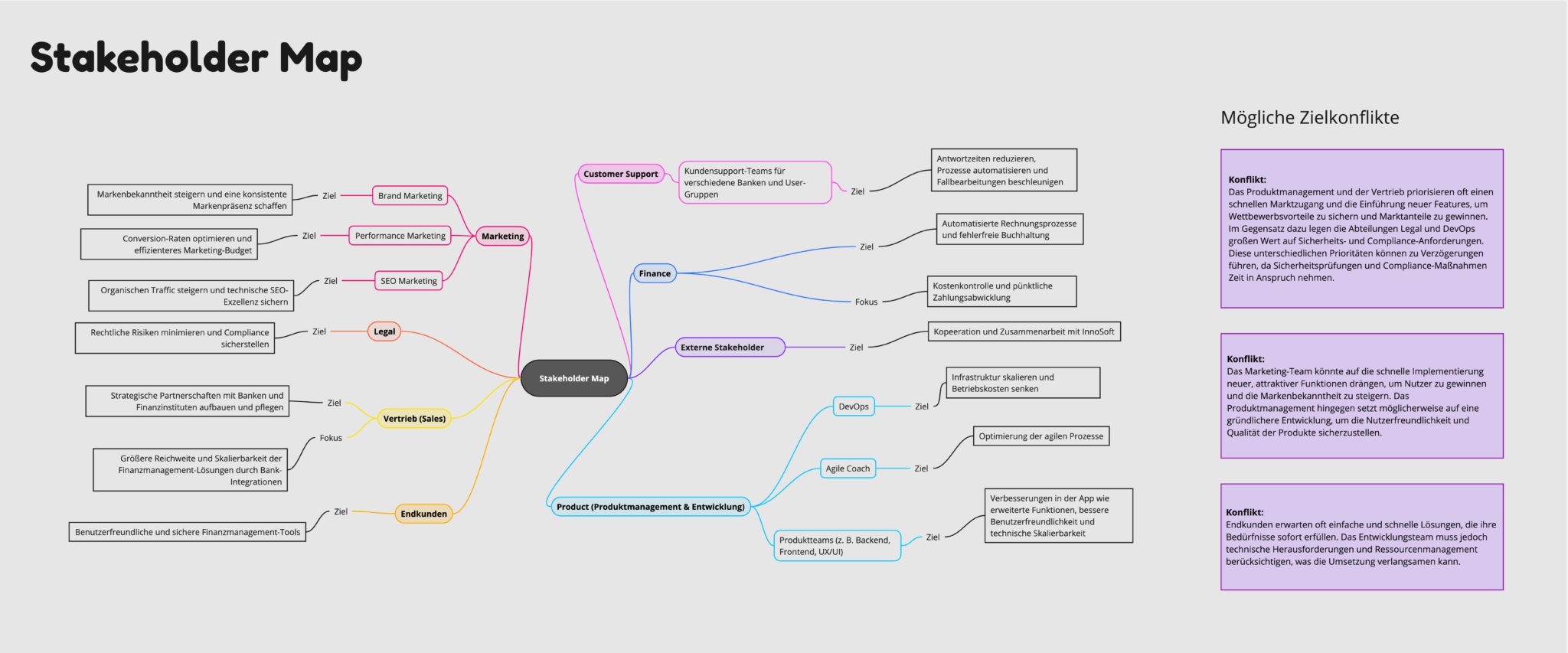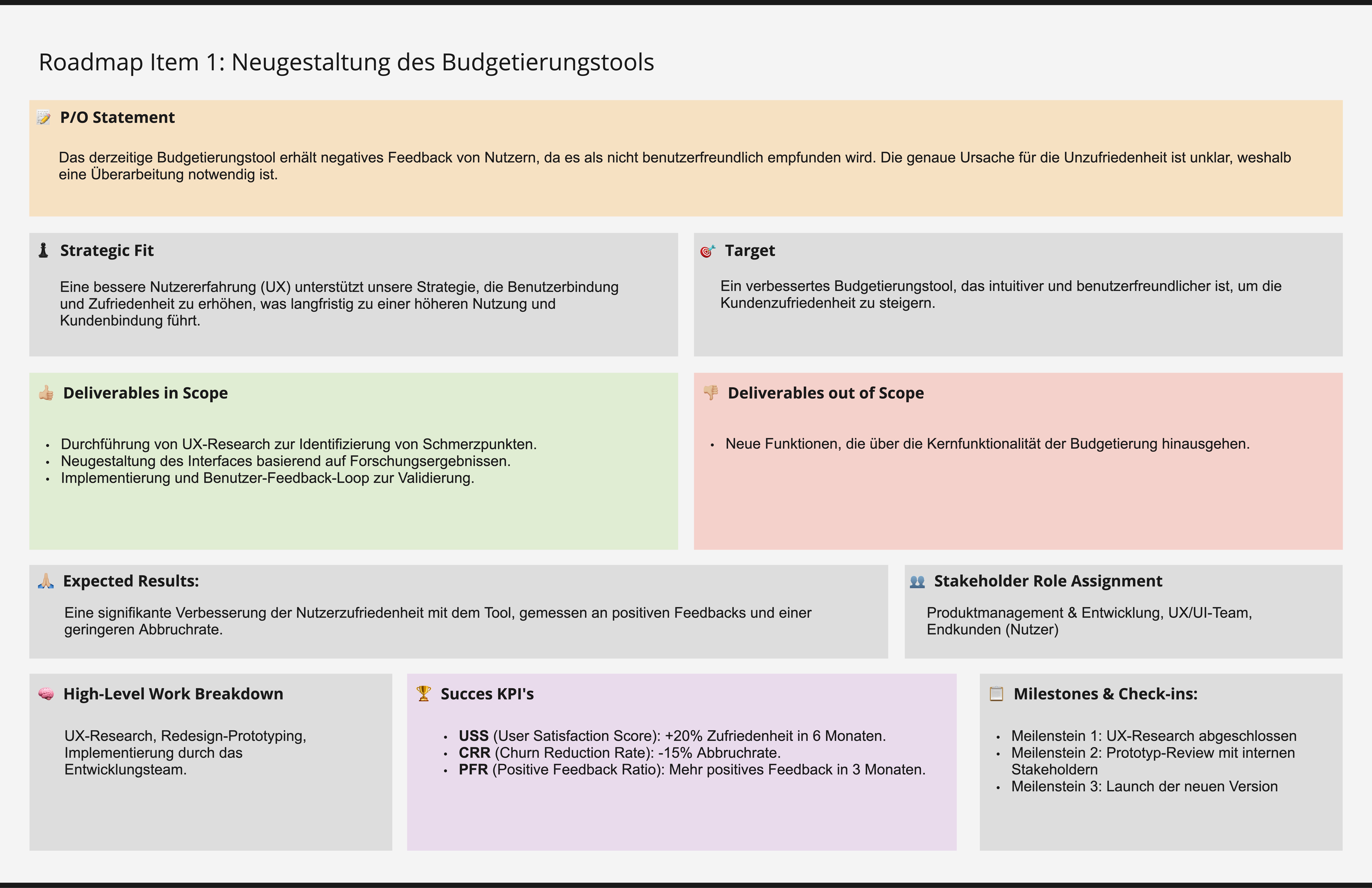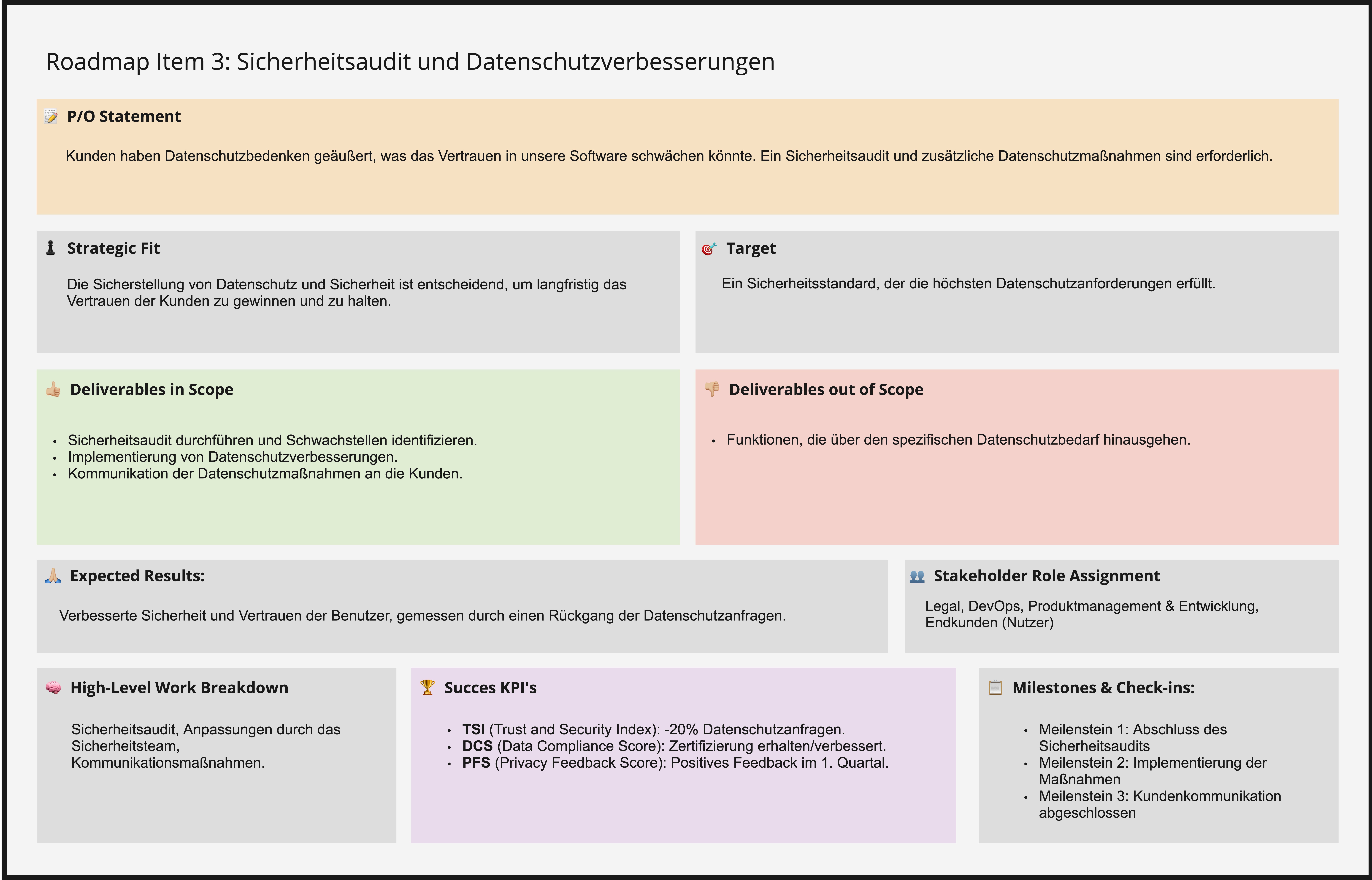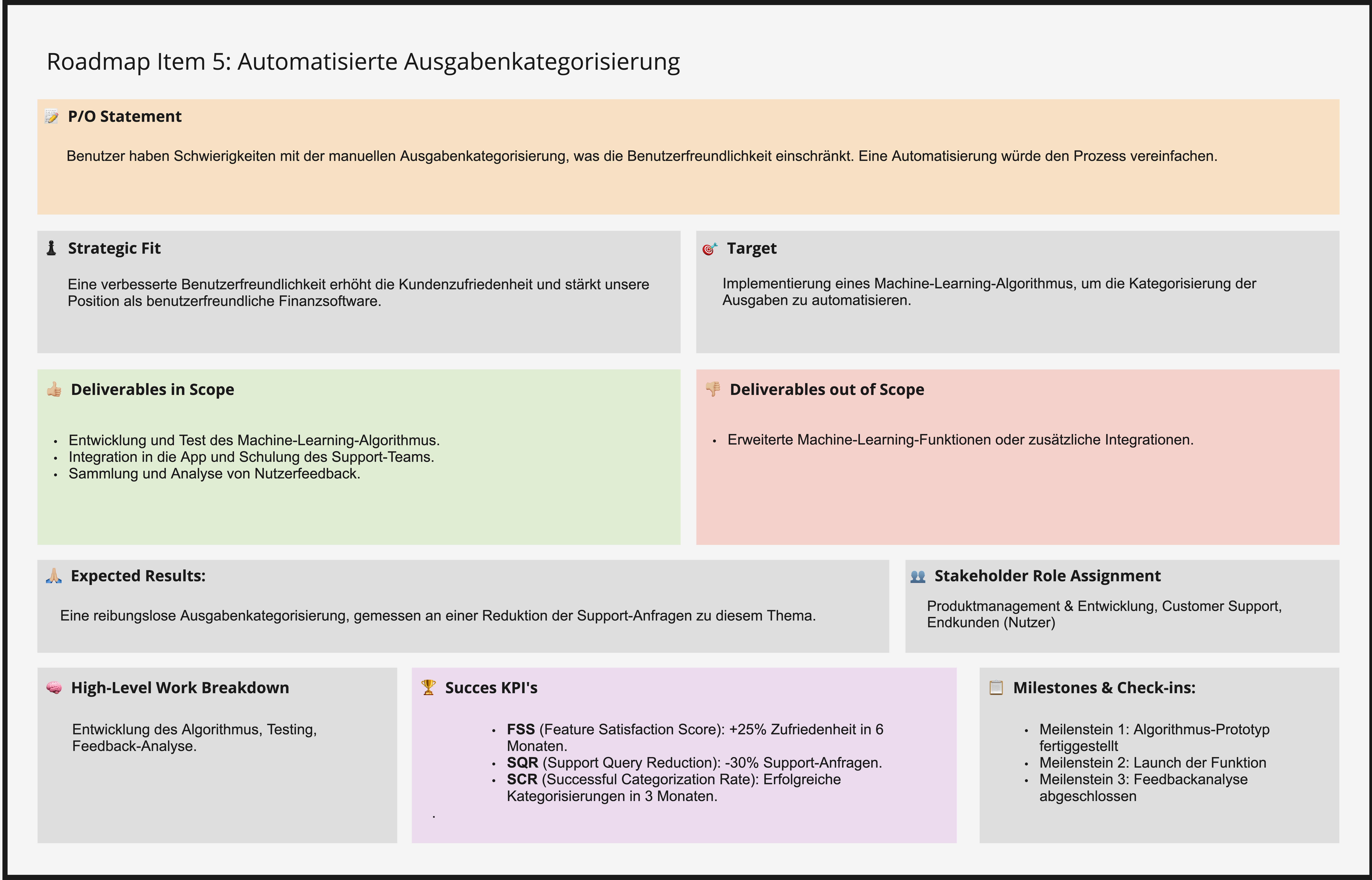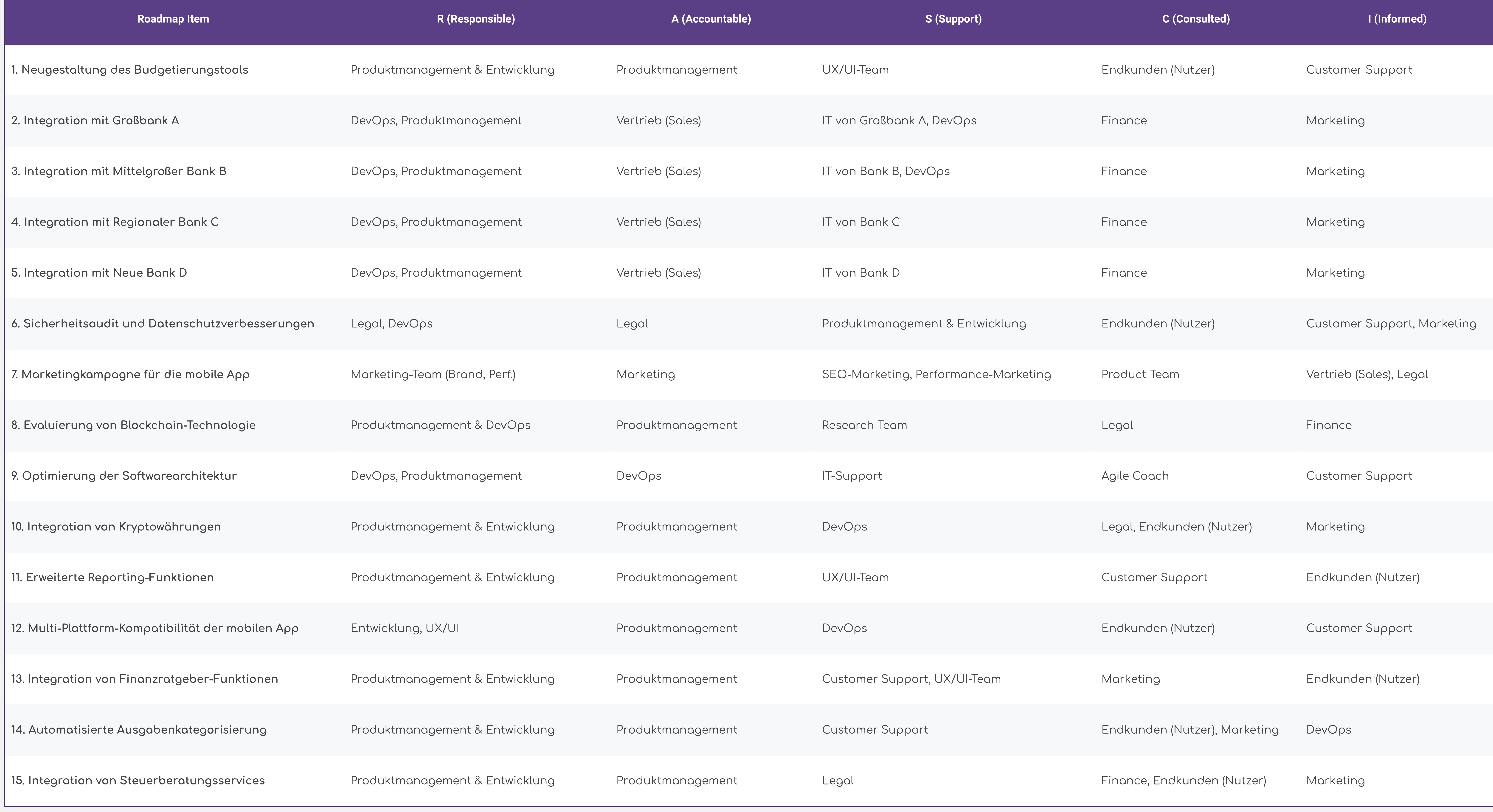Product Management for Innosoft Solutions
Project Overview
This fictional project was developed during a one-week sprint as part of Module 7: Roadmapping. The objective was to simulate a real-world product management challenge: designing a strategic product roadmap for InnoSoft Solutions, a company building a personal finance management app for the German market.
The project was structured around individual work and covered all essential aspects of roadmap creation: stakeholder identification, prioritization of features, tool selection, roadmap structuring, and strategic communication. The result had to reflect the ability to think and act like a product manager in a realistic environment with limited time and resources.
The goal was not only to prioritize features, but also to align business strategy with user needs, stakeholder interests, and technical feasibility over a realistic timeline from January 2025 to August 2026.
Stakeholder Mapping and Conflict Identification
The first task involved building a complete stakeholder map to understand the organizational environment and potential internal or external frictions. Key stakeholders included product development teams, DevOps, legal, marketing, finance, customer support, and bank partners. Each group had different goals, such as reducing infrastructure costs, increasing brand visibility, or ensuring compliance. This mapping exercise allowed me to identify where goal conflicts might arise—for example, between legal compliance and SEO-driven content expansion, or between product teams and marketing timelines.
Roadmap Tool and Format Selection
For roadmap creation and visualization, I chose to use the Kanban format within the tool awork. The decision to go with Kanban was based on the nature of the project: it was in an early phase with many unknowns, making it important to remain flexible and continuously adapt to shifting priorities and new inputs.
Kanban allowed for clear visualization of ongoing, planned, and completed initiatives across multiple phases. The tool awork was chosen for its intuitive interface and strong support for team-based workflows, including visual task management, team coordination, and stakeholder transparency.
Problem-Opportunity Statements and Roadmap Planning
In the next phase, I created Problem-Opportunity Statements for five prioritized features, covering issues such as the poor usability of the budgeting tool, the urgency of integrating with a major banking partner, and the need for a security audit in response to user concerns.
For each feature, I defined scope, measurable KPIs (e.g. +20% User Satisfaction Score, -15% Churn Rate), high-level deliverables, and stakeholder responsibilities based on a simplified RACI model. Each initiative was assigned a timeline and implementation window within the roadmap, considering development resources and business priorities.
The roadmap was divided into four strategic phases over a 20-month period, from Q1 2025 to Q3 2026. High-priority features like security improvements and key bank integrations were placed early in the roadmap. More experimental or complex initiatives, such as the evaluation of blockchain technology or tax advisory integrations, were placed in later phases.
RASCI Matrix
To ensure clarity in responsibilities and communication, I created a RASCI matrix (Responsible, Accountable, Supporting, Consulted, Informed) for the key roadmap items. This framework helped align all stakeholders from the beginning, assign clear roles, and reduce ambiguity during implementation.
The matrix covered roles such as Product Owner, Backend and Frontend Developers, DevOps, UX/UI Design, Marketing, Legal, and external banking partners. Each roadmap item was mapped with this structure to show ownership, decision-makers, and communication needs across departments.
Using RASCI also supported stakeholder engagement during roadmap planning and laid the foundation for transparent, cross-functional collaboration throughout the project.
Kanban Board and Phased Roadmap
To structure the implementation timeline, I organized the roadmap using a Kanban board divided into strategic phases. Instead of using the typical “To Do”, “In Progress”, and “Done” structure, I defined custom phases:
Phase 1: Trust-building and mission-critical integrations
Phase 2: Core user experience improvements
Phase 3: Feature expansion and market differentiation
Phase 4: Long-term innovation and optimization
Each roadmap item included assigned team roles from the RASCI matrix, KPIs, and delivery timelines. This approach made dependencies and ownership visible and supported iterative planning across the product lifecycle.
Roadmap Timeline
The roadmap covered January 2025 to August 2026, broken down by quarter. Initiatives were planned to avoid team overload and allow for iteration and feedback.
Phase 1 (Q1–Q2 2025): Security audit, Bank A integration, budgeting tool redesign
Phase 2 (Q3 2025): Automated expense categorization, advanced reporting
Phase 3 (Q4 2025 – Q1 2026): Multi-platform support, cryptocurrency integration
Phase 4 (Q2–Q3 2026): Blockchain evaluation, tax advisory, legacy bank integration
This timeline balances value delivery, feasibility, and organizational capacity while creating transparency for internal and external stakeholders.
Stakeholder Communication Strategy
To simulate real-world complexity, I developed a stakeholder communication scenario where conflicting priorities needed to be addressed. The situation involved tension between the Marketing and Legal teams: while Marketing wanted to launch dynamic, localized SEO pages as part of the mobile app campaign, Legal raised concerns about data compliance and regulatory risks.
In this scenario, I used the roadmap as a communication tool to facilitate alignment. By clearly showing dependencies, deliverables, and timelines, I was able to highlight how delaying legal input could jeopardize the campaign’s success. I prepared a structured meeting briefing that included:
– Context and stakeholder goals
– The specific challenge (SEO expansion vs. compliance readiness)
– Proposed options and trade-offs
– A decision framework aligned with the product strategy
– Roles and preparation required for each participant
The goal of this communication plan was not just to solve the immediate conflict, but to demonstrate how roadmaps can be used proactively—to create shared understanding, manage risks, and foster collaborative decision-making.
Outcome
This project demonstrates my ability to approach product development strategically, structure complex information, and translate competing stakeholder goals into a coherent roadmap. Through a combination of prioritization frameworks, realistic timelines, stakeholder alignment, and KPI-driven planning, I was able to simulate the work of a product manager under real-world conditions.
Beyond the technical output, the project emphasized ownership, clarity, and cross-functional thinking—key skills in delivering sustainable digital products.

